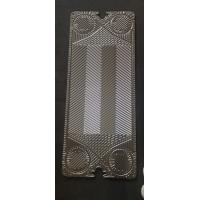| Sign In | Join Free | My himfr.com |
|
| Sign In | Join Free | My himfr.com |
|
| Ask Lasest Price | |
| Brand Name : | APV SPX |
| Model Number : | H17、N35、N50、J060、J092、J107、J185、B063、A055、A085、Q080 Q030、Q055、R8G1、A145、TR9L4、TR9L3、TR9L2、TR9L1、SR14GD |
| Certification : | ISO SGS |
| Price : | 50 - 500pieces $20-$30 |
| Payment Terms : | T/T, L/C, Western Union, |
| Supply Ability : | 50000pcs per month |
| Delivery Time : | 15 days |
Product Description
Apv Spx Series Titanium/ Stainless Steel Plate Heat Exchanger Plates With Gasket
Heat Exchanger Plates
To choose a material for replacement heat exchanger plates for an APV SPX heat exchanger, you should consider several factors:
Compatibility: Ensure that the material you choose is compatible with the fluids being processed in the heat exchanger plate. Check for any potential chemical reactions or corrosion issues.
Operating Conditions: Consider the temperature and pressure conditions the heat exchanger plate will be subjected to. Choose a material that can withstand these conditions without degrading.
Efficiency: Select a material that will maintain or improve the heat transfer efficiency of the heat exchanger plate.
Availability: Ensure that the chosen material is readily available and can be sourced easily for replacement heat exchanger plate.
Common materials used for heat exchanger plates include stainless steel, titanium, nickel alloys, and others. Consult with a heat exchanger specialist or the manufacturer for specific recommendations based on your requirements.
Heat Exchanger Plates material
1.Stainless steel SUS304 316 316L 310S 904
2. Industrial pure titanium and titanium-palladium alloyTi tanium
and Pal ladium
Sea water, salt water, salt compounds
3. Hastelloy Alloy
Concentrated sulfuric acid, hydrochloric acid, phosphoric acid
4. Nickel
High temperature and high concentration caustic soda
| Brand | Model |
| APV SPX | H17,N35,N50,J060,J092,J107,J185,B063,A055,A085,Q080 Q030,Q055,R8G1,A145,TR9L4,TR9L3,TR9L2,TR9L1,SR14GD |
| Material | Specification |
| Stainless Steel | SUS304 316 316L 310S 904 |
| Titanium and titanium-palladium alloy | TAi TAi-Pd |
| Hastelloy | C276 D205 B2G |
| Nickel | Ni200 Ni201 |
| Molybdenum | 254 |
Applacations
The application areas of heat exchanger plates are as follows:
1. Widely used for Hotels
2. Garment Shops
3. Building Material Shops
4. Machinery Repair Shops
5. Manufacturing Plant
6. Food & Beverage Factory
7. Farms, Restaurant,Retail, Food Shop
8. Printing Shops, Construction works
9. Energy & Mining, Food & Beverage Shops
Q&A
Question: What is a plate heat exchanger used for?
Answer: A plate heat exchanger is used to transfer heat between two
fluids without them coming into direct contact with each other.
Question: Where are plate heat exchangers commonly used?
Answer: Plate heat exchangers are commonly used in HVAC systems,
refrigeration, food processing, chemical plants, and various
industrial applications.
Question: How does a plate heat exchanger work?
Answer: A plate heat exchanger works by allowing two fluids to flow
on either side of the plates, with heat being transferred between
them through the plates.
Question: What are the advantages of using a plate heat exchanger?
Answer: Plate heat exchangers offer efficient heat transfer,
compact design, easy maintenance, and versatility in handling
different fluids and operating conditions.
Question: How can plate heat exchangers help in energy efficiency?
Answer: Plate heat exchangers can help improve energy efficiency by
transferring heat effectively between fluids, reducing energy
consumption in heating and cooling processes.



|




